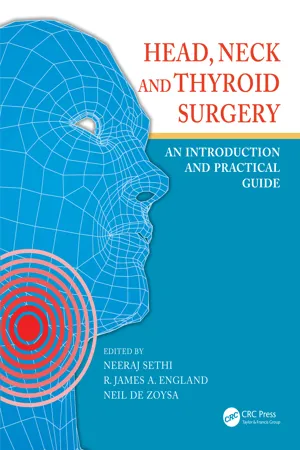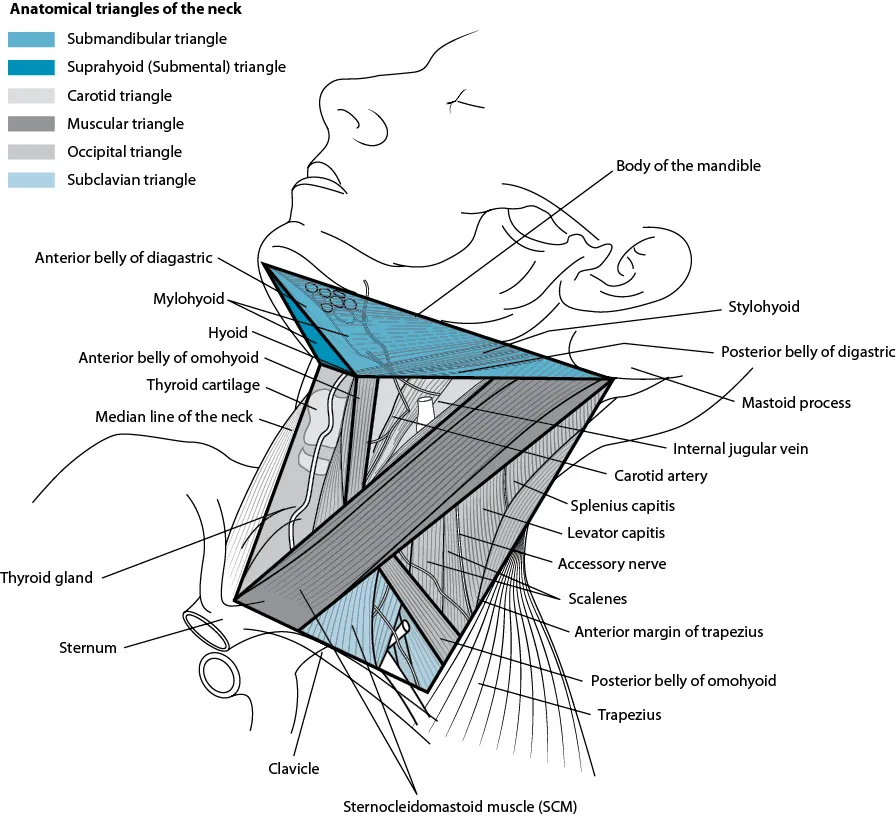
eBook - ePub
Head, Neck and Thyroid Surgery
An Introduction and Practical Guide
- 246 pages
- English
- ePUB (mobile friendly)
- Available on iOS & Android
eBook - ePub
Head, Neck and Thyroid Surgery
An Introduction and Practical Guide
About this book
This book covers the clinical approach to managing head and neck pathology as it presents to the otolaryngology department. Including cervical lymphadenopathy, salivary gland disease, oral, oropharyngeal, laryngeal and hypopharyngeal lesions as well as thyroid and parathyroid diseases. Each chapter presents an evidence-based, practical, and user-friendly approach to assessing, investigating and managing these patients
- A practical, clinically applicable guide to managing head and neck pathology
- An evidence-based approach to the clear guidance provided in the book.
- Colour images and flow charts for quick reference
Clear, concise and comprehensive, Head, Neck & Thyroid Surgery: An introduction and practical guide will be useful to trainees and clinicians in otolaryngology, maxillo-facial and plastic surgery.
Frequently asked questions
Yes, you can cancel anytime from the Subscription tab in your account settings on the Perlego website. Your subscription will stay active until the end of your current billing period. Learn how to cancel your subscription.
No, books cannot be downloaded as external files, such as PDFs, for use outside of Perlego. However, you can download books within the Perlego app for offline reading on mobile or tablet. Learn more here.
Perlego offers two plans: Essential and Complete
- Essential is ideal for learners and professionals who enjoy exploring a wide range of subjects. Access the Essential Library with 800,000+ trusted titles and best-sellers across business, personal growth, and the humanities. Includes unlimited reading time and Standard Read Aloud voice.
- Complete: Perfect for advanced learners and researchers needing full, unrestricted access. Unlock 1.4M+ books across hundreds of subjects, including academic and specialized titles. The Complete Plan also includes advanced features like Premium Read Aloud and Research Assistant.
We are an online textbook subscription service, where you can get access to an entire online library for less than the price of a single book per month. With over 1 million books across 1000+ topics, we’ve got you covered! Learn more here.
Look out for the read-aloud symbol on your next book to see if you can listen to it. The read-aloud tool reads text aloud for you, highlighting the text as it is being read. You can pause it, speed it up and slow it down. Learn more here.
Yes! You can use the Perlego app on both iOS or Android devices to read anytime, anywhere — even offline. Perfect for commutes or when you’re on the go.
Please note we cannot support devices running on iOS 13 and Android 7 or earlier. Learn more about using the app.
Please note we cannot support devices running on iOS 13 and Android 7 or earlier. Learn more about using the app.
Yes, you can access Head, Neck and Thyroid Surgery by Neeraj Sethi, Neil De Zoysa, R. James A. England, Neeraj Sethi,Neil De Zoysa,R. James A. England in PDF and/or ePUB format, as well as other popular books in Medizin & Hals-, Nasen- & Ohrenheilkunde. We have over one million books available in our catalogue for you to explore.
Information
1
Anatomy and differential diagnosis in head and neck surgery
Neeraj Sethi and Neil de Zoysa
Introduction
When assessing patients it is vital to formulate a differential diagnosis based on the initial history and examination. This guides decision-making in investigating patients swiftly and appropriately. Lack of investing thought into a differential diagnosis will lead to delays and unnecessary anxiety for the patient. Knowledge of the anatomy is essential to understanding what the pathology could possibly be. Whilst primary malignancy in neck lumps can occur (e.g. lymphoma, thyroid cancer or salivary gland cancer), the majority of malignant neck lumps are metastatic and immediate thought must be given to identifying the source of the primary tumour (which is likely to be in the upper aerodigestive tract).
Additionally, Occam’s razor suggests a unifying diagnosis to be the most likely correct diagnosis. This is often the case and makes sense in the setting of a patient with a sore throat, altered voice and a neck lump, where a differential diagnosis including hypopharyngeal carcinoma explains all symptoms. However, Hickam’s dictum must be remembered which states ‘a man can have as many diseases as he damn well pleases’, and there will always be patients with multiple pathologies.
Whilst the anatomy for each subsite of the upper aerodigestive tract is considered in more detail in each specific chapter, here an overview will be provided to ‘set the scene’ for a general assessment of the patient referred to a head and neck surgery clinic. As well as anatomy, the patient’s age, associated symptoms and risk factors for specific illnesses will guide differential formulation.
Anatomy
Triangles and levels
The neck is an anatomically complex but quite beautiful arrangement of vessels, cranial nerves, peripheral nerves, muscles and fascia.
For the purposes of clinical medicine and surgery, the neck can be broken down into triangles which are defined by palpable landmarks. This aids in both clinical examination and surgical planning.
From an operative point of view however it is equally important to understand the fascial planes of the neck. Generally speaking, these planes and their boundaries can be followed during surgery. By doing this, a clean operative field can be obtained ensuring complete and safe surgery via the relative ease at which important anatomy can be identified and preserved.
Important palpable bony landmarks are identified in Figure 1.1. These include the lower border of the mandible, the mastoid tip, the hyoid bone, the cricoid cartilage, the sternal notch, the clavicle and the anterior border of the trapezius muscle.

Figure 1.1 Triangles of the neck.
Using these landmarks, the neck can be divided into triangles as shown in Figure 1.1. The submandibular triangle has its superior border at the lower border of the mandible. It is then made up by the digastric muscle, which has two bellies running from the lesser cornu of the hyoid, one to the mastoid tip and one towards the digastric fossa of the mandible, just lateral to the symphysis (midpoint of the mandible).
Between the two anterior bellies of the digastric muscle and the body of the hyoid is the suprahyoid (submental) triangle.
The carotid triangle runs from the posterior belly of the digastric muscle to its insertion at the mastoid tip, then down the posterior border of the sternomastoid muscle, then up along the omohyoid muscle towards the lesser cornu of the hyoid. The omohyoid muscle is palpable in slim or muscular patients. As a surrogate, a line can be made from the lower two-thirds of the sternomastoid muscle to the lesser cornu of the hyoid.
The muscular triangle runs below this line (the omohyoid), the remaining sternomastoid muscle and the midline.
The occipital triangle is bordered by the posterior border of the sternomastoid muscle towards the mastoid tip, then along the anterior border of the trapezius, along the clavicle back to the sternomastoid. The subclavian (or supraclavicular triangle) is found within the posterior triangle, bounded by the inferior belly of omohyoid, the posterior border of sternocleidomastoid and the clavicle [1].
For the purposes of oncological description and axial imaging, the triangles are replaced by levels (see Figure 1.2 and Table 1.1). Levels are a more reproducible way of describing the location of pathology and should be used in preference to triangles in documentation, correspondence and discussion. In addition, the l...
Table of contents
- Cover
- Half Title
- Title Page
- Copyright Page
- Contents
- Preface
- Editors
- Contributors
- Abbreviations
- 1. Anatomy and differential diagnosis in head and neck surgery
- 2. Imaging in head and neck surgery
- 3. Perioperative issues
- 4. Congenital neck lumps
- 5. Cervical lymphadenopathy
- 6. Thyroid disease
- 7. Parathyroid disease
- 8. Oral cavity
- 9. Oropharynx
- 10. Hypopharynx
- 11. Larynx
- 12. Nasopharynx
- 13. Sinonasal tumours
- 14. The salivary glands
- 15. Paediatric neck lumps
- 16. Reconstruction in head and neck surgical oncology
- Index